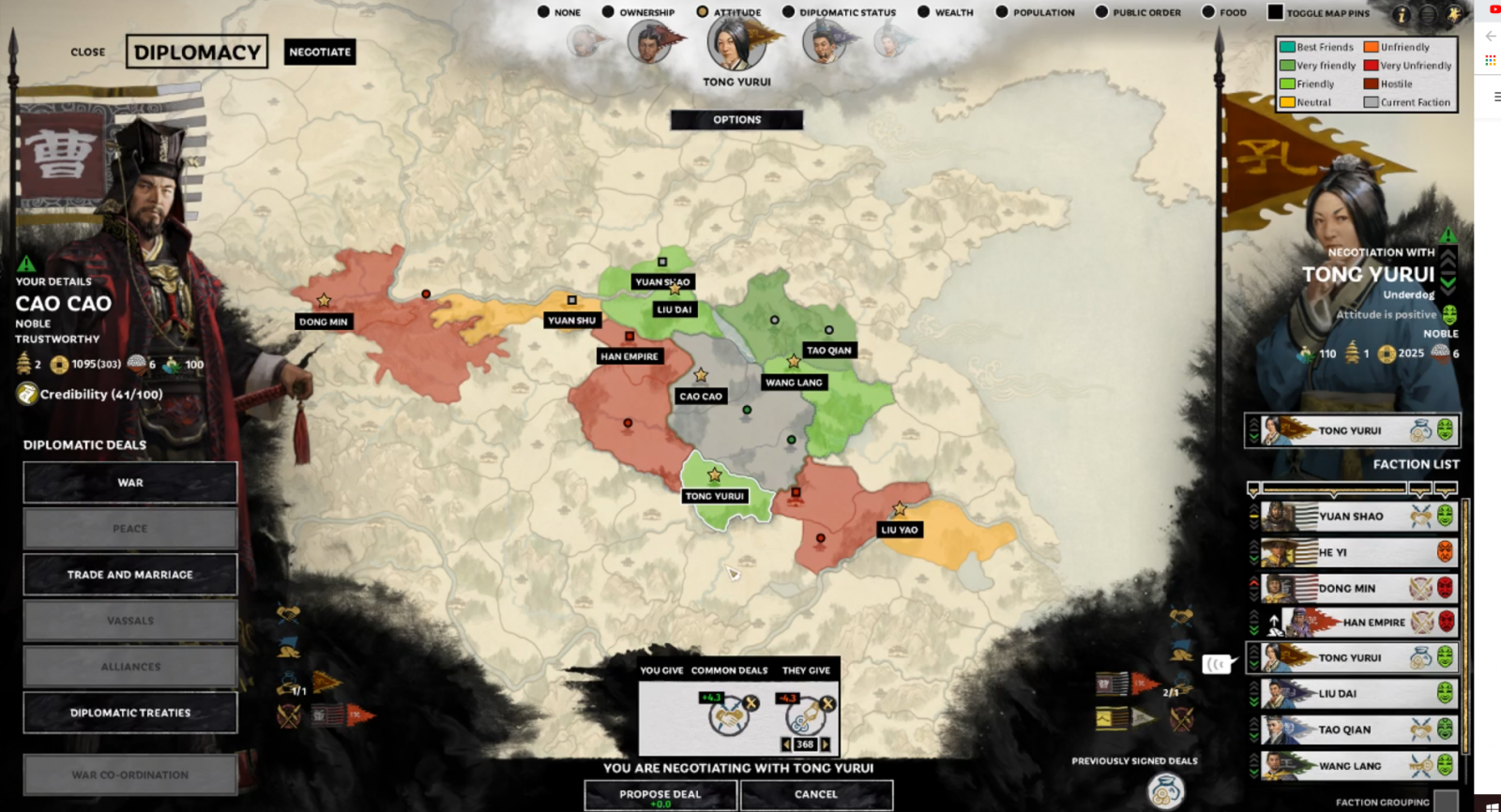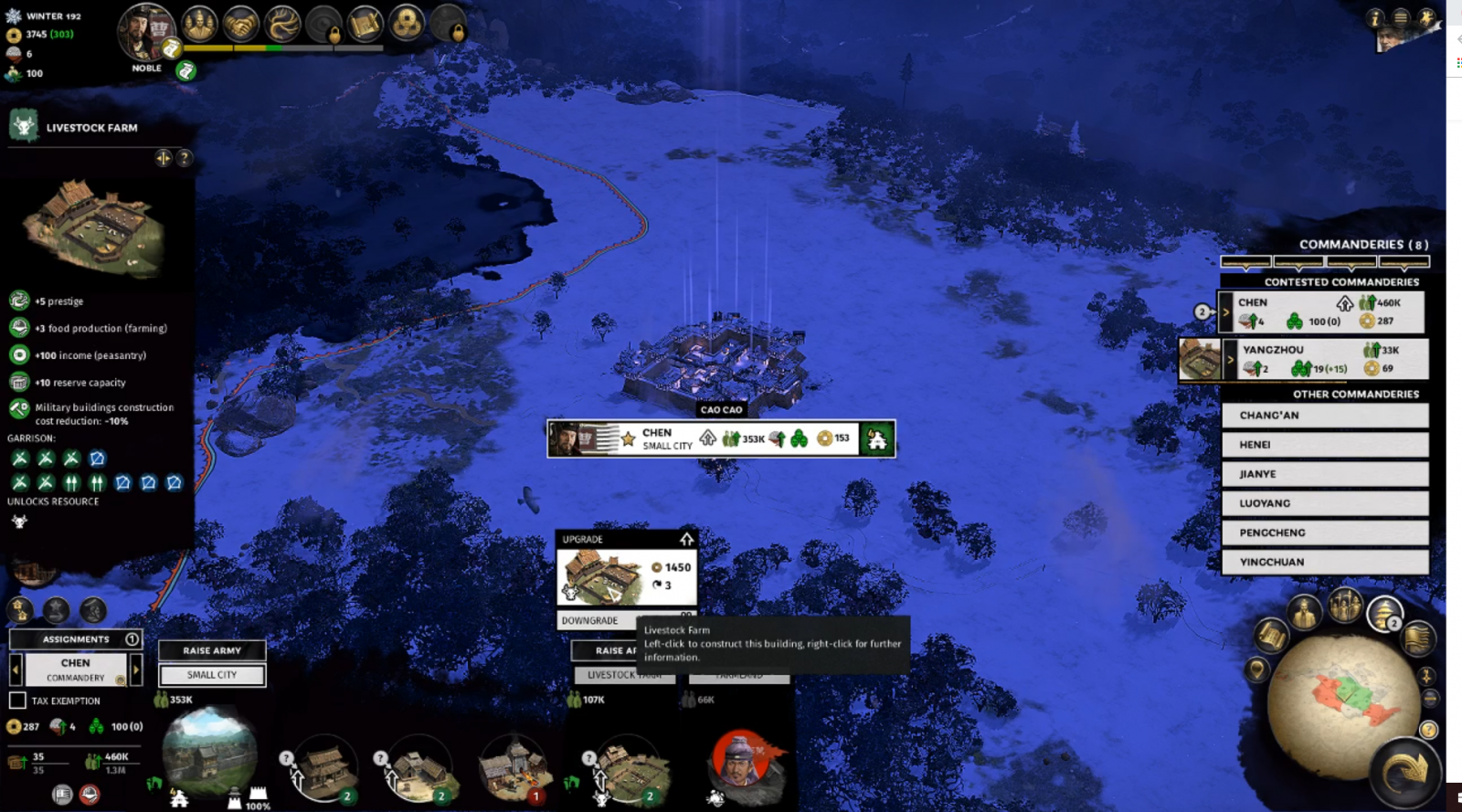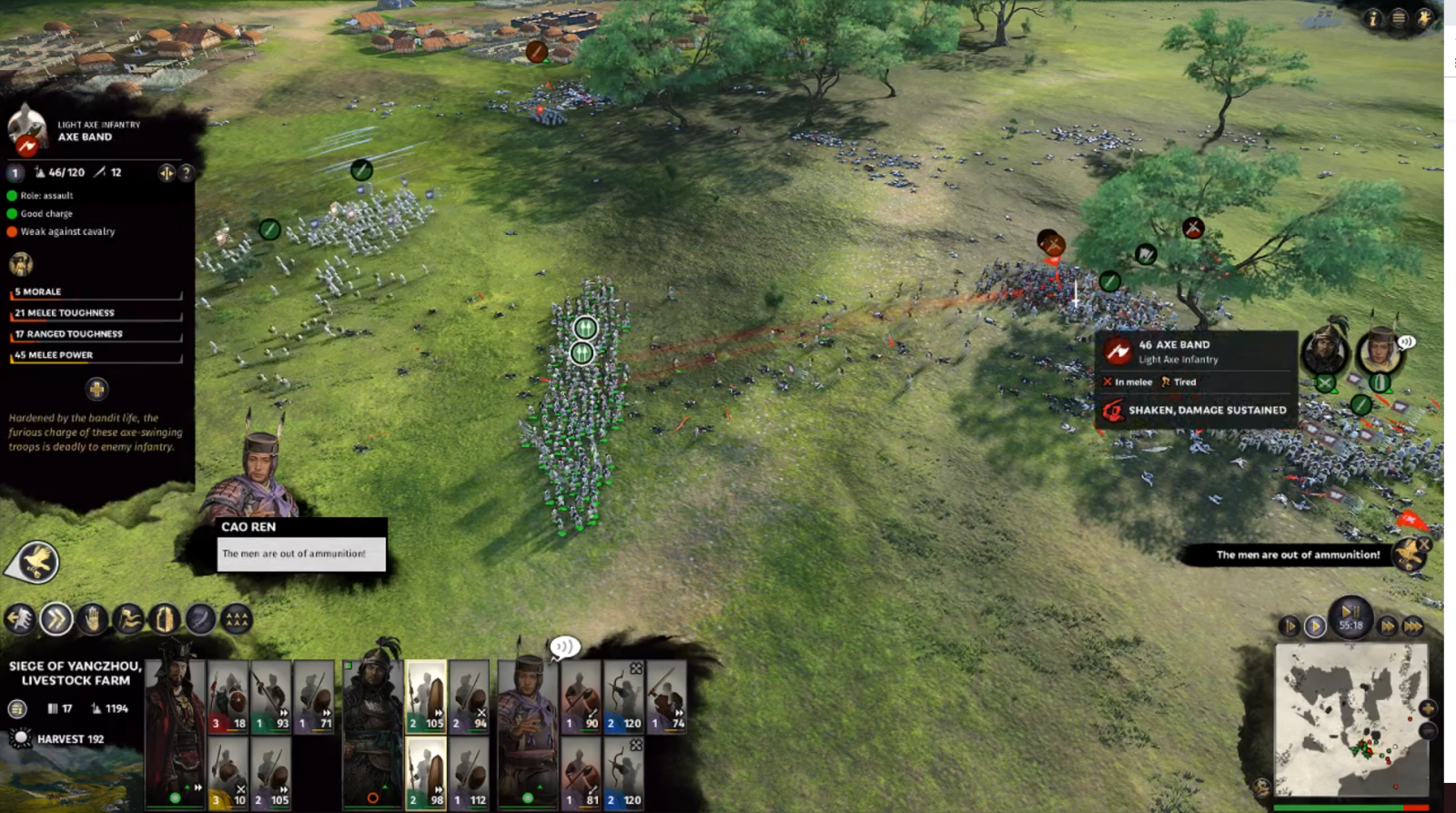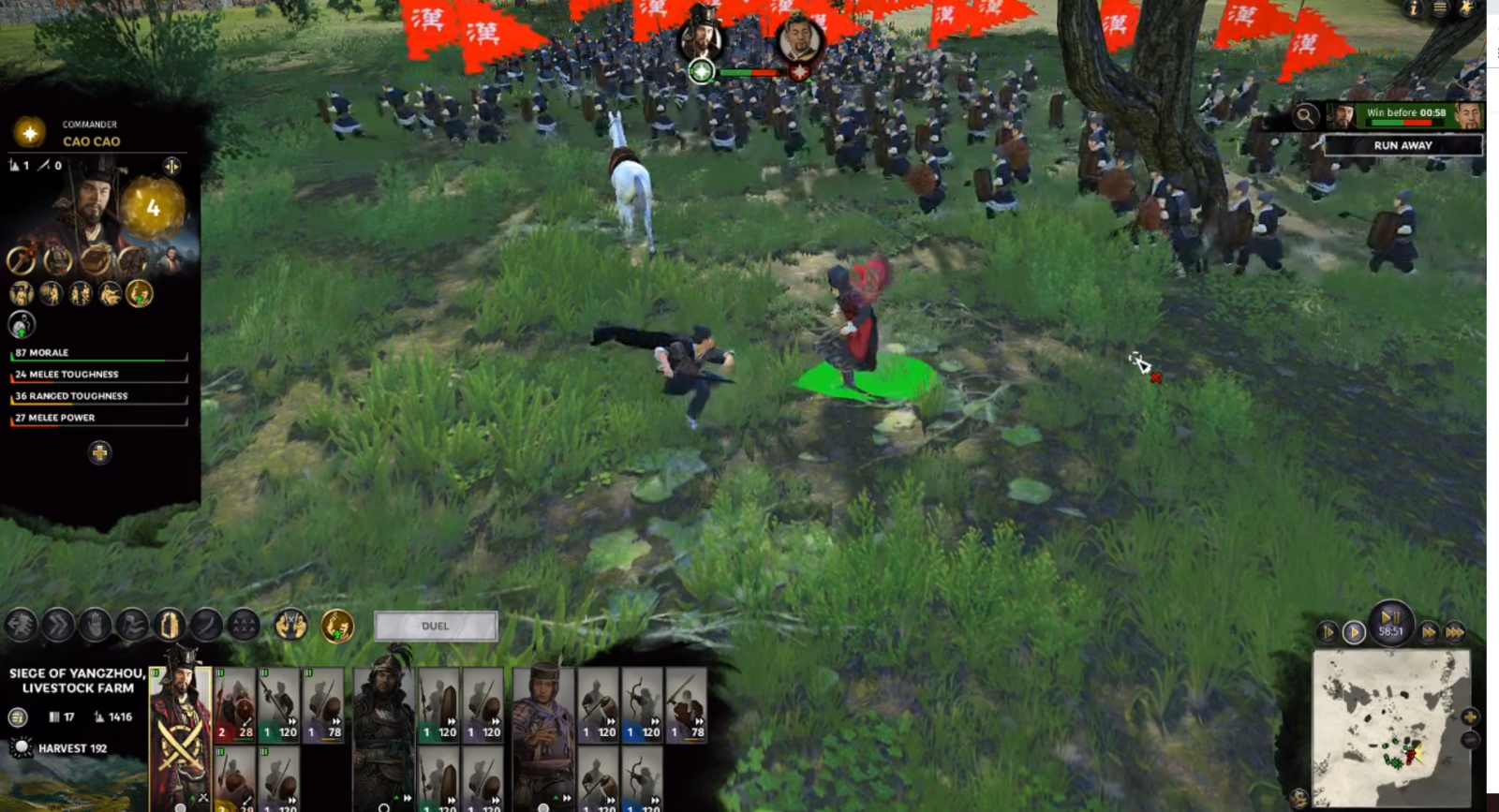
Mankind’s history is filled with love, war, advancements, tragedies, unification, divisive conflict, and so much more. One such time that contains all of mystery and intrigue is the Three Kingdoms period of China’s history. During this time, there are many who desire to control China for various means and will do whatever it takes to accomplish this. Some want riches and power, while others only want China to be unified in peace. Total War: Three Kingdoms puts you in the shoes of warlords and task you with achieving their personal goal, whatever it may be. There may be a lot to keep track of and strategize, but this newest addition to the Total War series does a fantastic job with giving you the tools of a warlord.
The main mode of the game is the campaign, where you’ll step into the shoes of various warlords and work towards their goal to become emperor. Each warlord has their own difficulty associated with their campaign, ranging from easy to very hard. For anyone new to the series (like me for example, save for my preview event experiences), Cao Cao’s campaign is the best place to start. He prefers to take a more diplomatic approach, but can still build up armies and fight just as well as anyone else. Cao Cao’s goal is to build up relationships, earn the support of the people, take advantage of corruption in order to end it, and ultimately unify China in peace. His goal is my favorite, even if he’ll manipulate others in order to achieve it; it shows how dedicated he is to the greater cause. Along with the different difficulties, each warlord has their own scenarios and events that come into play during their campaign.

A majority of the game takes place on an overworld map; here you’re able to look over the territories, who controls them, and move all of your moves outside of battle. Your relationships with territories and their rulers is color coordinated; shades of green represent different states of friendliness, yellow shows a neutral feeling, and shades of red represent various levels of conflict. These relationships change based on deals, negotiations, and battles that may have taken place. The starting relationships depend on what history has shown, but you can influence this during your time playing. You’ll want to make strong allies and not upset anyone that will crush you without a second thought.
Deals can be proposed by you on your turn or even by other warlords and generals during their turns. If a deal isn’t appealing enough to either of you, it can be declined. There’s also room for negotiation, which can be helpful if you can squeeze out a little bit extra for yourself. Deals can be anything from payments of food or money to opening trade routes to arranging marriages to non-aggression pacts, and much more. There are no limits to the number of people you can make deals with, so feel free to have at it.

In order to grow your population and expand your empire, you’ll need to acquire more land and build. Building new structures and upgrading them is a great start before venturing out. You need to spend gold to build and it takes a designated number of turns for each task to be completed. You can only have one building project going on at a time per commandery/territory, so choose wisely. The game mentions that if you aren’t building something, then you’re wasting time. If you have plenty of money to spend, then that’s true, but sometimes you need to let your funds increase a bit before making any big purchases. Speaking of money, you need to make sure you’re receiving a good amount of income per turn. Most buildings have an upkeep cost per turn, which you’ll want to keep in mind when building them.
Different buildings have different effects, which lets you focus on what you want taken care of. For example, farms and grain storage help with food production, military structures help with military might and maintaining public order, tax collection agencies increase your income, and more. Looking at stats such as public order, food reserves, income, etc are crucial if you want to have a successful run. If you don’t pay attention to these and let them get too low, then things may go very badly for you, even ending your campaign. Your citizens may starve, leave your empire, or rebel against you; you could even go bankrupt and not be able to support anyone.

Each turn you have a limited amount of action points. These points are represented by a bar, which shows you how much you can move your armies around. An army is represented by whoever is leading it walking around the map as a large figure, which in my case was Cao Cao. After making them move, the bar drains and they stop once it empties. In order to move again, you must wait until your next turn. Complete all actions that you want done during a turn before hitting the end turn button in the bottom right corner. This prompts all other characters to take their turns, but thankfully it goes by fairly quickly. You aren’t forced to watch multiple long turns before getting back to your own, so don’t worry.
Now, before getting to the actual combat, you’ll want to make sure your armies are built up enough to handle a fight. You can recruit more soldiers for designated costs in order to boost your ranks. Troops that you recruit don’t start off fully formed; they take a few turns to reach their full numbers, so you’ll want to hold off on rushing them into battle right away. It adds a nice sense of realism because you can’t expect 120 cavalry men to be ready to fight as soon as you request them. It’s a bit of a bummer having to wait sometimes, but it doesn’t hurt the game much. You’ll have access to units such as swordsmen, spearmen, archers, mounted units, shield-wielding units, and more. Depending on your current unit composition and battle strategies, the troops that you recruit may vary dramatically compared to others who are playing.
The battles themselves start with a deploy phase where you decide where you want each set of units to begin.; the same can be done with your generals. Once you’re ready, it’s time to start the battle. Quickly discovering your enemy’s troop composition and formations is important and will help you plan your moves. You’ll want to flank any units that you can, rush archers to keep them from raining down on your troops, and wipe out your foes while reducing your own casualties. If you decide to go for a full frontal assault with no formation changes or planning, then be ready for plenty of unnecessary bloodshed. Any units you lose are gone until you recruit more or replenish them over time, so you want to minimize losses.

As the battle rages, you’ll want to be ready to constantly change orders for different troops as the battle changes. When one group of units wipes out enemy forces nearby, you’ll want to quickly send them to help out other groups that could use them. If enemy reinforcements arrive, you may need to send more units to protect some of your own, or even make a strategic retreat. Retreating enemies will be chased down by whoever was attacking them unless you give them a new task. The point is, you need to be on the lookout for any turning tides or unexpected events.
Warlords and generals are extremely important, in both romance and records modes. In romance mode, they are overpowered, legendary warriors that are based on stories and incredible feats that have been told throughout the ages. They have large amounts of health, strength, endurance, and even access to special abilities. Some can unleash attacks such as sweeping sword strikes, powerful fire arrows, and brutal charges, while others gives buffs to their troops such as damage resistance, increased projectile evasion, and more. In records mode, they are normal warriors escorted by bodyguards. They are just as vulnerable and capable as they realistically would be, providing a more accurate experience for you. This means that they must be protected more instead of being allowed to rush into hordes of enemies like they would in romance mode. In either mode, one of these leaders being killed results in a large hit to troop morale. They may not fight as hard and even be terrified enough to retreat altogether. If your all-powerful general was taken down, would you feel capable of completing your task as a run of the mill soldier? I think not.
There are also a whole slew of other things you can do and take into account as you play. I’ll briefly touch on them here because otherwise this review will go on forever. You can send spies to join other factions in order to obtain secret information, you can appoint generals and other followers to positions in your court in order to help you rule and maintain public order, and reforms are available at the end of every fifth turn. Reforms give you options of changes that will be made in your empire. These changes benefit different aspects of your empire depending on what you choose. Some focus on agricultural advancements, others focus on income collection, one route boosts military projects, and another helps out the diplomacy route. There’s a lot of content packed into the game, so there’s plenty to keep you busy.

Besides the campaign mode, you also have access to historical battles and custom battles. Historical battles lets you take part in some of the famous battles from this period’s history, while custom battles lets you use everything available to create your own matches. You can set a budget limit then choose warlords, generals, and soldiers to make up your army. Each of these options has their own cost associated with them, so keep an eye on that budget. The AI opponent follows the same rules as well, and you can choose what they have as well if you wish. It’s cool to be able to jump into a mode where you can focus purely on the combat without any outside consequences to story or future events. If you’re in the series purely for the large scale battles, then this is the mode for you.
Speaking of large scale battles, it’s still amazing to me how many soldiers can be in a battle at once without the game slowing down. I had battles with hundreds of soldiers going at it without any issues. The environments look breathtaking and I couldn’t help but fly around with the camera to get a good look at everything. The same thing can be said for the troops as well; I zoomed in plenty of times to follow units as they charged towards their enemies and even to watch a few duels between generals. Even with such a grand scale of combat, it’s refreshing to get a more personal look at what is going on down below. The sound design is crisp and clear as well, whether it be soldiers marching through grass or water, generals shouting orders, troops yelling battle cries, or even the clashing of weapons. It gives a more engaging sense of being in control of a battlefield.
The difficulty and gameplay itself is definitely not for everyone. It’s not bad by any means, but it’s geared more towards those with an affinity for patiently strategizing, multi-tasking a plethora of factors, and spending hours of time with seemingly no progress. That last part may sound bad, but compared to other games, you may not get much done in an hour or so. Total War: Three Kingdoms is about the long game and it stays true to that aspect in a satisfying way. If you try to rush the game and not take your time, then you’ll most likely get stuck or lose quickly. Trust me, I got too anxious on my first attempt as Cao Cao and realized that I needed to change my strategy. The difficulty will likely vary from person to person depending on your familiarity with this series or games like it. This was my first introduction to the series, and even though I’m not personally great at it, I see how much it has to offer. For fans of large-scale, multi-tasking strategy games, you surely won’t be disappointed.
Total War: Three Kingdoms
Great
Total War: Three Kingdoms is a fantastic addition to the series, taking place in the Three Kingdoms period of China's history. The gameplay requires patience and strategizing, but is satisfying when successful. With plenty of aspects to manage, you won't be wanting for something to do, although it may be too much for some gamers.
Pros
- Fascinating period of China's history
- Engaging, large-scale battles
- Your actions determine your path
- Beautiful visuals, in and out of battle
Cons
- Amount of aspects to manage can be too much for some
- Being impatient can get you stuck or end your run
